This street food with eggs and mince slathered on French bread is ‘a joy to eat’
Cooking expert, teacher and author Tony Tan shares how to make a delicious baguette loaded with fresh herbs, spices, omelette and curried meat, plus two styles of dumplings from his latest cookbook.
Victorian-based cook Tony Tan has spent more than four decades cooking, eating, teaching and writing about the foods of Asia.
Now he shares his lifetime of expertise and experience in Tony Tan’s Asian Cooking Class, a collection of more than 150 of his most popular and personal recipes from Malaysia, China, Vietnam, Japan, Singapore, Indonesia, Thailand and beyond.
From stir-fries to noodles, street foods to sweets, Tan’s recipes are known for their generosity, warmth and deliciousness.
Related Article
“Among more contemporary flourishes there are also everyday dishes from across Asia,” he writes in the introduction.
“Some are simple, requiring no more than a few ingredients and only a short time to prepare, while others are meant for occasions when you have a bit more time.”
Here are three recipes to try at home.
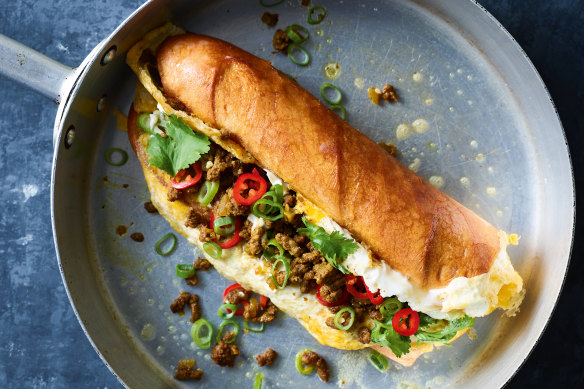
Roti John
This street food of minced beef or chicken with eggs slathered on French bread and fried is popular in Indonesia, Brunei, Singapore and Malaysia. This simple and delicious sandwich made its debut back in the 1960s when there was a British naval base in Singapore. Apparently, while the soldiers were stationed in Singapore, they would stop at a stall selling bread and omelettes. According to legend, as the stallholder saw all British soldiers as more or less the same, he would ask them this question: ‘Roti, John?’ Every British serviceman was referred to as John. Regardless of its origin, it really is a joy to eat. I’m surprised it hasn’t caught on in the West.
INGREDIENTS
- 80ml(⅓ cup) neutral oil or ghee
- 1 large onion, finely chopped
- 1 tbsp finely chopped lemongrass
- 1 garlic clove, minced
- 1-2 tbsp meat curry powder (such as Alagappa, or Cap Burung Nuri)
- ½-1 tsp chilli powder
- ½ tsp ground turmeric
- 1 tsp garam masala (see recipe below)
- 500g finely minced beef, lamb or chicken
- salt and white pepper, to taste
- 4 eggs
- 2 tbsp chopped Vietnamese mint
- 1 baguette, cut into 4 equal pieces
- softened butter, for brushing
- coriander sprigs, to serve
- sliced chillies, chilli sauce and tomato sauce, to serve
METHOD
- Heat a wok over medium-high heat, then add 2 tablespoons of oil. Once it’s shimmering, add the onion, lemongrass and garlic and stir-fry until the onion turns translucent.
- Meanwhile, mix the curry powder, chilli, turmeric and garam masala with enough water to make a paste. Add to the wok and cook for 2-3 minutes, stirring constantly.
- Add the meat and cook, stirring now and then, until it is well coloured and the moisture has evaporated. Season to taste with salt and pepper, and add enough water to cover the meat. Bring to a boil, then reduce to a simmer and cook until all the liquid is absorbed. Leave to cool.
- Beat the eggs in a large bowl, then add the cooled meat mixture and stir to combine.
- Cut each piece of baguette in two lengthways (but not all the way through) and open them up.
- Generously grease a large non-stick frypan with the remaining oil, heat over medium-high heat, then add quarter of the omelette mixture and cook for 1-2 minutes, stirring and tossing until softly set. Open out a cut baguette and place it on top of the omelette in the pan, crust-side up, pressing gently so the omelette sticks to it. Cook until the omelette is firm, brushing some butter on top of the baguette as it sets.
- Remove the baguette and omelette with a spatula and fold together to form a sandwich. Top with coriander and sliced chillies and serve with a mix of chilli sauce and tomato sauce, to taste. Repeat with the remaining omelette mixture and baguette pieces.
Serves 4
Garam masala
Meaning hot spices, garam masala has many regional variations and every home has its family recipe. It is added towards the end of the cooking process. Packaged garam masala is a pale imitation of home-made blends. Many recipes call for black cumin or shah zeera, aka royal cumin, which is often confused with nigella seeds. My recipe uses regular cumin to avoid this confusion. Some cooks dry-roast the spices separately before grinding them to a powder, but I don’t.
INGREDIENTS
- 1 tbsp green cardamom seeds
- 5cm stick cinnamon, broken into bits
- 1 tsp whole cloves
- 1 tsp black peppercorns
- 1 tsp cumin
- ½ tsp grated nutmeg
METHOD
Place all the ingredients, except the nutmeg, in a spice or coffee grinder and blitz for 30 to 40 seconds to a fine powder, then mix in the nutmeg. Store in a small airtight container. I keep mine in the fridge.
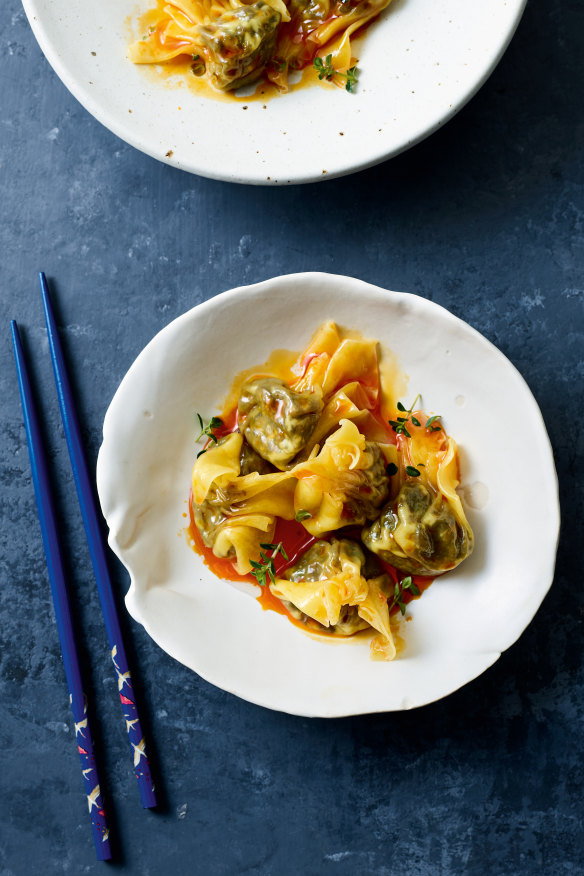
Mushroom dumplings with curry oil
This is a dish I created some years ago when a vegetarian friend dropped by unexpectedly for dinner. In my panic, I chopped up some mushrooms, fried them with aromats, chilled the mix, then folded it into dumplings. Once I pulled them out of the water, I tossed them with some fragrant curry oil I’d made earlier and the rest is history. The mushroom stuffing also works perfectly with a firm cheese such as a good cheddar, or firm beancurd, which you can add to the mix.
INGREDIENTS
- 24 wonton wrappers
Mushroom dumpling filling
- 5 dried shiitake mushrooms
- 2 tbsp olive oil
- 1 tbsp unsalted butter
- 2 garlic cloves, minced
- 2 shallots (eschalots), finely minced
- 1 tsp minced ginger
- 1 long red chilli, finely chopped
- 1 sprig thyme, leaves picked, plus extra leaves to serve
- 600g button mushrooms, chopped
- 1 tsp porcini powder
- salt and white pepper, to taste
Curry oil
- 180ml (¾ cup) neutral oil
- 2 tbsp curry powder
- 1 tsp minced ginger
METHOD
- For the filling, soak the mushrooms in hot water for 20 minutes. Drain and squeeze out excess water, discard the stems, then cut the caps into fine dice.
- Heat the oil and butter in a frying pan over medium heat, swirling to melt the butter, then add the garlic and shallots and fry until translucent. Add the ginger and chilli, then add the thyme, button mushrooms and diced shiitake mushrooms and cook, stirring occasionally, until most of the juices released from the mushrooms have evaporated. Stir in the porcini powder, season with salt and pepper and transfer to a bowl to cool.
- Meanwhile, for the curry oil, add all the ingredients to a small saucepan over medium heat and stir until fragrant. Season to taste with salt. Remove from the heat and leave until needed.
- To make the dumplings, lay out 8 wonton wrappers on a bench. Put about 1 teaspoon of the mushroom filling in the centre of each wrapper. Brush a little water along the edges of the wrapper, then fold one corner over the filling to the opposite corner to form a triangle, pressing the edges together to seal. Repeat with the remaining wrappers and filling.
- Poach the dumplings, in batches, in plenty of boiling salted water until they float to the surface. Remove with a slotted spoon and toss gently with the curry oil. Serve hot, topped with extra thyme leaves.
Serves 6-8
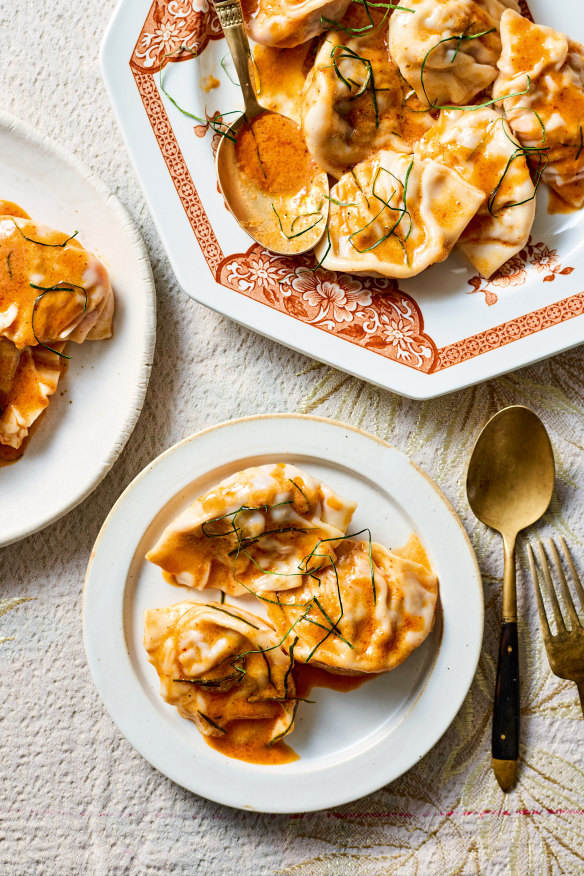
Thai curry duck dumplings
This dumpling came about accidentally. I had leftover duck curry in the fridge one day and, because it was slightly gelatinous, I thought I could add extra gelatine to make the sauce thicker, then stuff it into dumplings. I put teaspoonfuls of the curry into gau gee wrappers, then poached them. It was a hit with friends. Foie gras shavings are a marvellous topping for this dumpling.
INGREDIENTS
- 20 gau gee wrappers
Duck curry filling
- 2 tbsp red curry paste, or to taste
- 125ml (½ cup) coconut cream
- 500g Chinese roast duck meat, minced by hand
- 125ml (½ cup) coconut milk
- 2 makrut lime leaves, finely shredded
- 100g bamboo shoots or water chestnuts, finely diced
- 2 tbsp fish sauce
- 2 tsp palm sugar (or jaggery), grated
- 2 gelatine leaves
Curry sauce
- 500ml (2 cups) thin coconut milk
- 2-4 tsp red curry paste, to taste
- 1 tsp grated palm sugar (or jaggery)
- 1 tbsp fish sauce
- 3 makrut lime leaves, thinly sliced, plus extra to serve
- ½ tsp paprika
- pinch of salt, or to taste
METHOD
- For the filling, add the red curry paste and half the coconut cream to a saucepan and stir constantly over medium heat until fragrant. Stir in the duck meat, then add the remaining ingredients, except the gelatine. Simmer for 10 minutes. Meanwhile, soften the gelatine leaves in a little cold water.
- Squeeze out excess water from the gelatine, then stir it into the hot curry until dissolved. Remove the curry from the heat, cool, then refrigerate for 6 hours or until set.
- Meanwhile, for the curry sauce, combine the coconut milk, curry paste, palm sugar and fish sauce in a saucepan and bring to a gentle boil, stirring occasionally. Add the lime leaves and paprika, then check the seasoning and add a little salt if you think it needs it. Keep warm.
- Place the gau gee wrappers on a clean surface. Spoon 1 teaspoon of filling on one half of each wrapper, brush the opposite edge with water and fold over to form a half-moon. Pinch the edges together to seal.
- Poach the dumplings, in batches, in boiling salted water until they float to the surface. Remove with a slotted spoon and serve immediately with a spoonful of the curry sauce and extra sliced lime leaves. You can use the rest of the sauce as a dipping sauce.
Makes 20
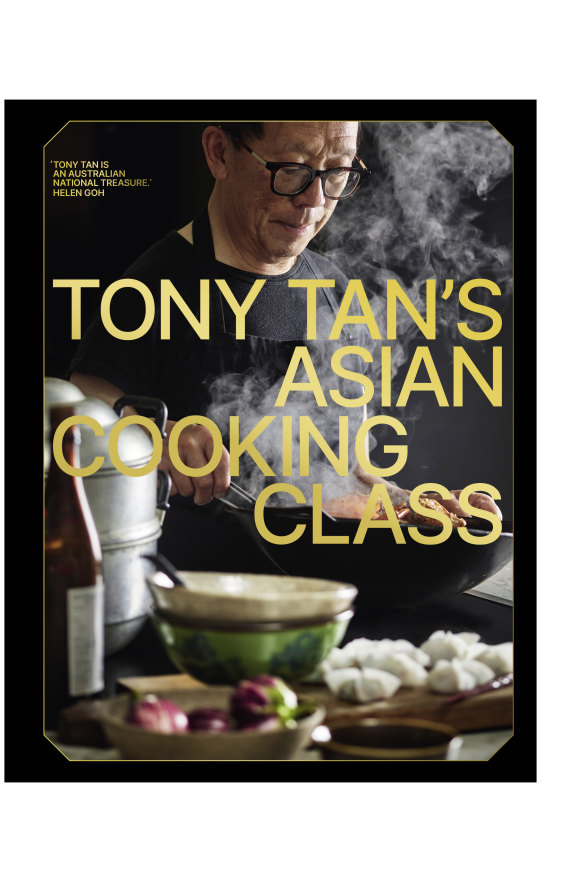
This is an edited extract from Tony Tan’s Asian Cooking Class by Tony Tan, published by Murdoch Books, RRP $59.99. Photography by Mark Roper.
Meet Tony Tan
Join Tony Tan at the Sydney launch of his new cookbook, Tony Tan’s Asian Cooking Class, at Paski Vineria Popolare in Darlinghurst on Monday, October 28, for a four-course “Italy meets Asia” set menu inspired by Tan’s recipes from across South-East Asia.
$100 a head (includes a signed copy of Tan’s cookbook; excludes drinks), dinner bookings via OpenTable
Continue this series
Here are recipes from 30+ of the best cookbooks of 2024Up next
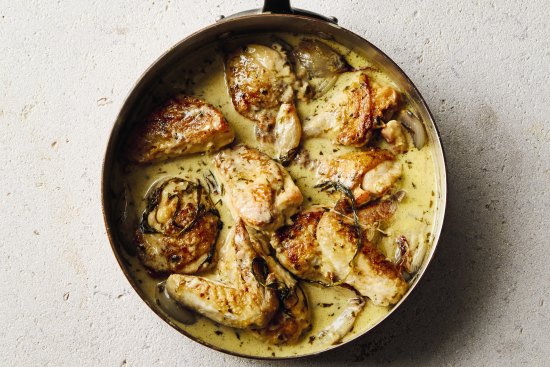
This creamy tarragon chicken from Julia Busuttil Nishimura is a go-to retro classic
Plus a chargrilled marinated lamb leg with romesco and a King George whiting dish with braised peas from the Melbourne cook and recipe writer.
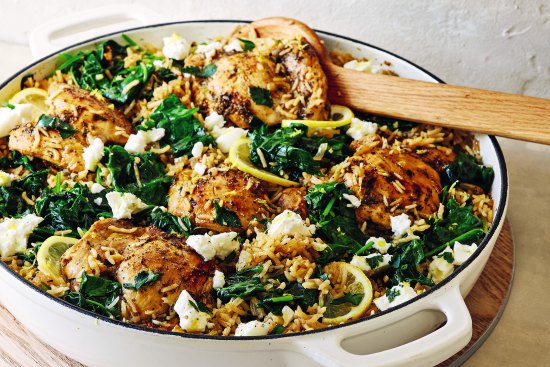
Your new favourite chicken one-pot: ‘Anyone who eats this is bewildered by how delicious it is’
This budget-friendly Greek chicken and rice dish is low fuss and great to make ahead.
Previous

Raid the pantry for these cheap and cheerful recipes from Jamie Oliver’s new cookbook
The superstar chef shares midweek hits like a chicken noodle traybake, jarred capsicum pasta and tin-raid fishcakes – plus his kitchen and pantry essentials.
The best recipes from Australia's leading chefs straight to your inbox.
Sign up